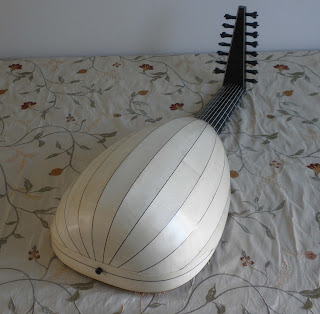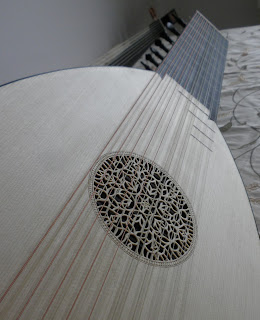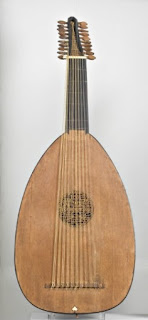Renaissance Lute based on Hans Frei (Vienna KHM C34)
This is a popular model due to is body size and string length of 61cm.
(For prices on instruments please visit the main website www.jminstruments.com)
6 course lute
The 6crs unique features are a thicker parabolic cross-section neck as seen above and an octave on the 4th course, the pegbox tends to be nearly at right angles to the neck as seen on Renaissance paintings. The back is in cherry wood pegs and bridge in pearwood, neck in figured maple.
6 course lute based on Giovanni Hieber Venice c1580 ( Brussels M1561)
This is one of the few surviving renaissance lutes thats not been converted by lute makers from the past which is rare as most were valued due to age then recycled into a 10crs or baroque lute, below is a 6crs version, the original is a 7crs. String length of 59.7cm tuned to g'. The body depth is 14.8cm.
The rose is the same as on the original Hieber, a gold rose was made for the Heiber below
This instrument can be heard here
Ribs in English yew, figured Maple neck. The neck has the parabolic cross section seen on 6crs lutes thus the neck is thicker than later lutes which were made slightly less thick.
Renaissance Lute based on Hans Frei (Vienna KHM C34)
'Early c1532' 7 course
This 7crs is based on Hans Gerle's lute as well as the body and barring for the Frei.
Hans Gerle's book Musica Teusch 1532 has 3 pieces at the end for 7crs with octave tuning from the 7th course to the 4th as seen here. Also other features of Gerle's lute such as ebony edging to the fingerboard, and a bridge with carved flower ends, and heart shaped pegs in natural and black dyed pearwood. The peg box is more square in shape than triangular which is commonly seen in Renaissance paintings too.
7 course lute
61cm string length tuned in g', body depth 14.2cm.
Below is another Cypress ribbed lute in 7courses with the original rose:
Below is another Frei, 7crs with Indian rosewood ribs and black walnut neck and peg box
Another Frei, the upgraded student version, with Cherry wood ribs and figured maple neck and peg box
8 course
61cm string length tuned in g'
An 8 course lute covers a majority of the wealth of Renaissance lute repertoire
This is the original rose on the instrument.
The rose shown here is on another Frei (C33) but used on the C34 version, hear it being played below:
Hear it's owner playing O'Carolan's Fanny Power here.
Below is an 8crs Frei in Indian Rosewood with black walnut neck and peg box with black stained pearwood pegs, a good dark wood alternative to ebony veneered neck and peg box :
Below is a video of the instrument being played:
In contrast to this below is another 8crs, 63cm in f' (a=440Hz), made with holly ribs, a convincing alternative to ivory
This lute was made with fret positions in 1/6 meantone (tuned using Valloti temperament on the Korg OT-120 as recommended by Stewart McCoy)
8 crs lute based on Hans Burkholtzer, Fussen c1596 (Vienna KHM NE48)
String length 62.9cm tuned in g', the body depth is 14.8cm.
The Burkholtzer is a popular 10crs but this 8crs was created as stock, currently for sale (May 2020)
The bridge has decorative stars carved into it like the original Hieber lute.
Multi ribbed heartwood yew with black boxwood spacers, Black Walnut neck and peg box.
Heart and Sapwood English Yew wood Burkholtzer (left handed version), the shallow almost elliptical body cross section can bee seen below.
8 course lute based on Giovanni Hieber Venice c1580 ( Brussels M1561)
String length 59.8cm in g'.
The body has a more rounded 'apple' shape than the almond shaped Maler or Frei, the profile of the body shows the bottom of the instrument curving back inwards where the end pin is. The original rose is above and the original instrument is shown below:
10 course lute based on Hans Frei (Vienna KHM C34)
10 crs lutes cover all Renaissance repertoire, often seen as an instrument on the cusp of Renaissance and Baroque, in France they were using 10crs with new transitional tunings like the flat french tuning which lead to the new Baroque lute tuning in D Minor. 66.5cm string length tuned in f' (a =415Hz)(f, c, g, eflat, B flat, F, E flat, D, C, B flat). The body is 14.2 cm deep.
Indian Rosewood Ribs with natural boxwood spacers
Hear it being played below:
Below is the Hans Frei 10/11crs in Flamed maple
Above is an 11crs which can be used as a 10crs too.
Figured maple and Cherry back with ebony veneered neck and pegbox.
Cyress ribs with black boxwood spacers and a figured Maple neck and peg box.
10 course lute based on a lute labelled "Matheus Buchenberg, Rome" c1620 (Edinburgh 3249)
This is a large 10crs compared to the others with a 69.2cm string length tuned in f'(a =415Hz)(f, c, g, eflat, B flat, F, E flat, D, C, B flat), the body is 17.3cm deep.
Cypress Ribs, shown with sellas E547 Theorbo.
33 ribs in Pear, Black Walnut neck and pegbox
33 ribs in heartwood Yew. The instrument can be heard here. The original instrument is below:
10 crs lute based on Hans Burkholtzer (Vienna KHM NE48)
A popular choice is the Burkholtzer, shallow backed and comfortable the body is 14.8cm deep.
This was a left handed version, later converted to an 11crs as was often done historically with 10crs lutes. String length 64cm, the bridge was moved up slightly and a slightly longer neck to get 9 tied frets as requested.
Hear it being played here:
Indian Rosewood back and Black Walnut neck and Peg box, it can be heard here
This instrument has now been converted to a single strung 10crs with higher tension strings as seen below:
The new holes are in between the old, some old holes re-used and not filled in so it can be changed back to a standard double strung 10crs. A recording of this instrument with it's new strings can be seen below:
10 crs lute based on Venere (Vienna KHM C36)
This is a small body in length but still as deep as a Buchenburg, string length 66.7cm tuned in f', the body depth is 15.9cm.
Ribs in indian rosewood with natural boxwood spacers and ebony veneered neck and pegbox
The Tieffenbrucker above is another 10crs with Figured maple ribs, neck and pegbox, black stained pearwood pegs, the video of it is below:
Other Lutes to order:
George Gerle (Vienna KHM A35) String length 59.4cm in g', 15.9 cm deep.
Hans Frei (attributed to) (Vienna KHM C37) String length 58.7cm in g', 12cm deep, 26cm wide.
Laux Maler c1550 (Nurenburg MI 54) String length 66cm in f', Body depth of 14.5cm.
Matheus Pocht, Innsbruck 1519 (currently the oldest surviving lute body) so likely to originally have been in 1519 a 6crs bass lute in d' or a lute in f' (if tuned at a=380Hz 'Renaissance pitch', Segerman 2003).
It can be made to be tuned in d' in gut (or higher at e' if strung in Nylgut) with a string length of 70.8.
Or made as a shorter 7crs in e' at 68.4cm, both string lengths with the standard 8 frets on fingerboard, lower bridge position (as indicated on the original instrument and on a similar surviving lute by Maler MI54), depth 15.1cm.
Pietro Railich (MI45) The most rounded bodied lutes I've seen, currently exists as an 11crs but can be made as an 8-9 crs at 58.6 cm in g' a=440Hz (in nylgut), 8 frets on the fingerboard or as a 10 crs in g' (a=415Hz), of f' in gut at 61.4cm. The body is 14.4cm deep, 34.6cm wide, so quite a voluminous body but comfortable flattened back. Also would make a good Luito Attiorbato or archlute as it may have originally been.
W. Eberle (Vienna KHM C39/40) 7crs treble lute string length 43.7/44.2 in c', 10.5/7 cm deep.
W.Eberle (Vienna KHM C41) 4 crs octave lute in g'' String length 29.7cm.
shown below:
Raphael Mest of Fussen, 1623 (Linkoping) currently a rare surviving 12crs, 6-7 crs at 48.4cm with 8 frets on the fingerboard, or 50.7cm with 9 frets on fingerboard. 10/11crscrs at 50cm with current neck.. 13cm deep.
Laux Maler c1550 (Nurenburg MI 54) String length 66cm in f' (Nylgut). Or made as the likely original Bass lute in d (gut), e in Nylgut, String length 73.6cm. What is left of the original instrument is shown below. Body depth 14.5cm.
Wolfgang Wolf (d.1591) (Stadtmuseum Nr 4669) a rare surviving 12crs but likely to have been a 7crs, remnants of filled in fingerboard points coincide with a 7crs neck width.
6-7crs strung at 61.5 in g' (in Nylgut) f' in gut, with 8 frets on fingerboard as usual. Alternatively 62cm, 8 frets, in g' or f' with lower original bridge position (bridge marks on the soundboard). Of course it could be made as a 10crs in g' a=415Hz (in Nylgut) f'- f' sharp in gut with it's current bridge position and string length 63cm.
Lute labelled D[G] c1500 (NMM 3384) 5 or 6 crs String length 50cm, 11.6cm deep. A scaled down version of this can be ordered at 38.4 cm, 8.9 cm deep.
Magno Stegher, Venice (Bologna Civico Museum No 1754)10crs Great Bass lute 89.7cm,18cm deep, 42.3cm wide, a rare survival that hasn't been converted to a Chitarrone, most likely to be an early 'Chitarrone' with two re-entrant strings but no extended neck.
M.Harton, Padua 1599 (Bologna Civico Museum No 1808) Originally a Bass lute then an early 'chitarrone' 10crs string length, estimated at 75.9cm (currently exists as a cut down length of 70cm)
Other lutes which exist as Baroque lutes can be made (back) into Bass or Tenor lutes as they originally were.
STUDENT LUTES
7crs Renaissance student lute based on Hans Frei (C34)
String length 61cm tuned in g'
7crs based on Hans Frei (C34) £1167 excluding case.
Listen to it Dowland' Mrs Winter Jump played on the above instrument here. Also listen to another Frei lute made a few years earlier here being played by Richard Mackenzie
7crs Renaissance lute based on W. Tieffenbrucker (C36)
7crs Student lute based on Tieffenbrucker (C36) in f' a=440Hz. Cherry wood ribs, alpine spruce soundboard, bog oak fingerboard, or Indian rosewood, Nylgut strings. £ 1145, excluding case
This instrument can be heard here. This instrument is also available as a student 10crs at £1205 excluding case
Student Lute guitar based on Maler (MI54)
Based on the Maler (MI 54) in heartwood English yew, alpine spruce soundboard, maple neck and pegbox, pear wood pegs and bridge, bog oak fingerboard (the eco-alternative to ebony)Nylgut strings tuned in e' at a=440Hz can be played as a lute in e too by retuning one string a semitone for the same intervals of a lute. £1167 excluding Kingham case, usually circa £500. The instrument can be heard here
6 crs Renaissance lute or Childrens lute (Medieval lute body based)
Children's lute/ early renaissance lute based on the Medieval lute body but with renaissance barring and appearance based on paintings and iconography. £884, excluding case.
This instrument can be heard here
Below is one made with cherry ribs:


















































































